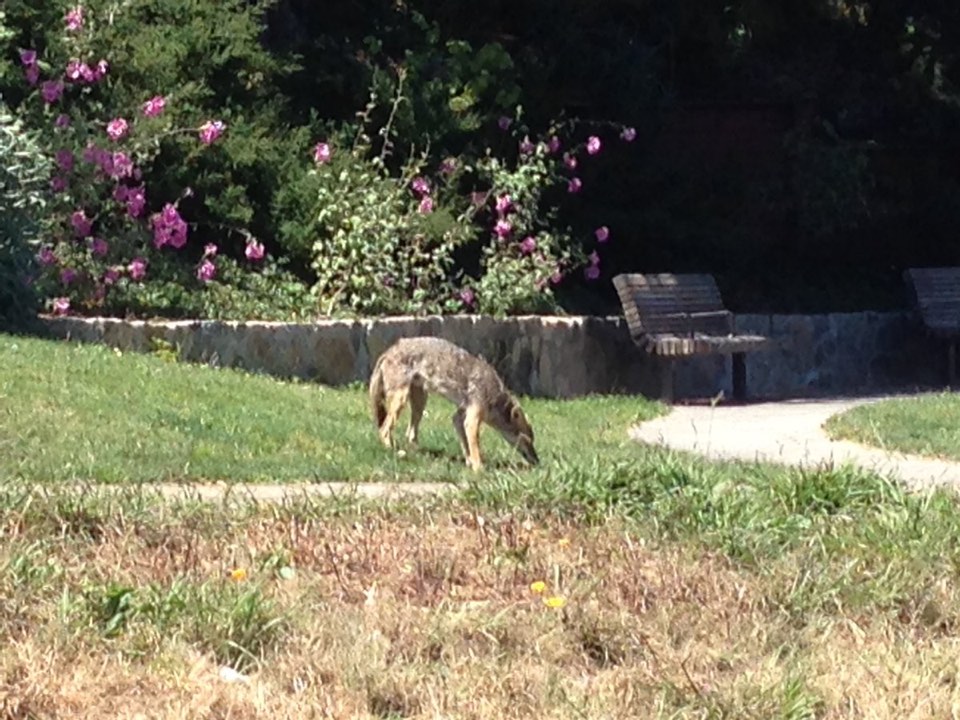
Last night, the founder of SF Native Tours posted a video on Instagram of two coyotes he and his guests ran into yesterday during a walking tour in Corona Heights Park.
Coyotes have been a trending subject as of late—over the past few weeks, readers have been writing in to Hoodline, and posting on sites like Nextdoor and Facebook, about hearing and seeing these wild creatures, wondering what to do in the case of a close encounter.
Stuart Watts of SF Native Tours told Hoodline that he and his fellow tour organizers, all born and raised in the city, have seen coyotes all around San Francisco over the years.
“We seem to run into them regularly on our 'Park-Pints-Politics' tour, when we walk through Buena Vista and Corona Heights,” he said. “I’ve always appreciated sharing our urban space with wildlife, and I’m thrilled to see when we respect their space.”
To clarify exactly what respecting their space should look like, we emailed some questions to Janet Kessler, a long-time San Francisco resident who's often referred to as The Coyote Whisperer.
Kessler has been studying coyotes for a decade. It all started in 2007 when she was recovering from a hand injury. She was walking her dog up to Twin Peaks, saw her first coyote, and was stunned by the animal’s intelligence, personality, joy, playfulness and curiosity, she said.
Through constant observation, Kessler became absorbed with coyotes' behavior and documents her learnings on her blog coyoteyipps.com—which has caught the attention of local and national news outlets, like the Examiner and the New York Times.
That said, here's a bit of co-existence guidance the Coyote Whisperer offered via email.
Coyotes have been quite loud lately in the Corona Heights/Buena Vista Park area. They’ve been howling, barking and almost screaming. Why might this be?
A couple of coyotes might sound like there are many more. Nevertheless, coyotes really are involved in their own lives and this is where the howling is directed.
They howl to communicate between themselves, they howl in response to sirens. They howl in distress when they've been chased by a dog.
They do NOT "howl when planning a kill." In fact, coyotes are rather quiet, they are hunters—usually hunting gophers and voles—they are quiet or their prey would run away.
Also, please know that mating season has just passed—coyotes may be communicating more loudly than usual during mating season.
What should people do if they encounter a coyote?
Coyotes are wary of humans—humans are bigger than they are—and will not approach us unless they have been trained to do so through food-conditioning. So please do not feed or befriend a coyote!
Give them the cold shoulder by practicing complete avoidance. Always walk away from a coyote so as not to crowd it or to invite friendship.
Wild animals may be unpredictable, but also we want our urban coyotes to remain wild by giving them the space they need.
What's your advice for neighbors with pets or small children?
Please don't allow your dogs to chase or interact with them. Coyotes see dogs as competition for scarce resources and territories, and small dogs and cats may be seen as prey when resources are scarce.
When out walking your dog, always be vigilant. If you see a coyote while you are walking your dog, it's best to leash and walk the other way, and pick up a small dog while you are walking away.
Keep walking away. You want to maintain distance. When a coyote follows you, usually out of curiosity, just keep walking—not running—away.
If you are feeling crowded by the coyote as you walk away from it, you may pick up a small stone and toss it TOWARDS—not AT—the coyote to scare it off, and then keep walking away.
During pupping season, which begins in late March, coyotes are particularly protective and may message dogs to keep them away from certain areas. They message through body stances, facial expressions and, ultimately, they may nip a dog, usually in the haunches, who intrudes on their space. Grab your dog as soon as you can, leash, and WALK away.
Don't let cats roam free, and don't leave pets unattended in your yard, even with a fence. Coyotes can jump a six-foot fence.
If you don't want them visiting your yard, remove all food sources, including dog food, compost, bird-seed and water. See the video "Coyotes As Neighbors" for a review of the coyote behaviors that concern us and our pets and what to do about them.
Small children should always be supervised when out of doors for many reasons: two-legged predators, cars and dogs, among others. Keep children away from all wild animals.
We all need to love and respect the coyotes, but it is their wildness we need to love, and their space we need to respect. It's really not hard to do.

If someone reports a coyote to Animal Control, what happens? It is illegal for animal control agents to relocate coyotes, correct?
Our Animal Care & Control supports coexistence. They also abide by the laws of the Fish and Game Department of the State of California, which prohibits relocation of coyotes.
Animal Care and Control takes note of reported sightings. If there was unprovoked aggression on the part of a coyote, ACC would come and assess the situation. ACC occasionally offers presentations on coexistence.
Note that, in my experience, all conflicts can be prevented by following coexistence guidelines—it's up to us to follow those guidelines.
Seems like there have been a lot of coyote sightings in the past 10 years. Are there more coyotes in San Francisco now than a decade ago?
Well, there are more than there were in 2000 when we had none. That's because coyotes were totally exterminated in the last century, and it was decades before they returned in 2002.
The population has grown since that time, but remember that coyotes need about a square mile of territory per coyote. What I've seen is about one family per park. A family consists of a mated pair and then several pups who eventually leave.
San Francisco only has 49 square miles, so as far as I know, we won't be overrun by coyotes. Coyotes are territorial and drive intruder non-family coyotes out of their claimed territories.
Also, once the carrying capacity of the land is filled, coyotes regulate their own numbers: survival rate for pups is only about 20-30 percent for their first year of life. Youngsters disperse from their families between the ages of 1 and 2 years—these will fill unclaimed niches in the city or move south. Dispersed youngster coyotes from San Francisco have been found 60 miles south of here.
Coyotes have amazing family lives. They mate for life and both parents raise the young. They play, have purpose and direction in their lives, and they have obstacles to surmount, including interpersonal relationships to work out within their own families—not so different from our own.
To learn more about co-existing with local coyotes—especially as pupping season nears—check out Kessler's articles 'How to Get Along With Coyotes As Pups Venture Out' and 'Coyotes Raising Kids In San Francisco,' or the video below titled "Citizen Coyote."









